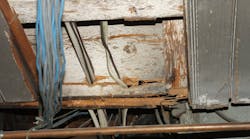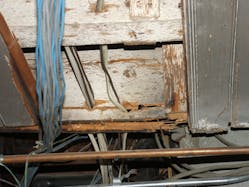How well do you know the Code? Think you can spot violations the original installer either ignored or couldn't identify? Here's your chance to moonlight as an electrical inspector and second-guess someone else's work from the safety of your living room or office. It's your turn to identify the violation.
Hint: Torn to pieces
Find the Answer
When running cables or raceways through holes drilled in wood framing members, such as joists, rafters, or studs, Sec. 300.4(A)(1) of the 2011 NEC requires the edge of the hole to be no closer than 1¼ in. to the nearest edge of the wood framing member. If this distance cannot be maintained, then 1/16-in.-thick steel plates shall be used to protect the cable or raceway from being damaged by nails or screws that may penetrate the wiring method. According to Exception No.1, steel plates are not needed to protect RMC, RNC, IMC, or EMT. Exception No. 2 permits you to use thinner steel plates if they are listed.
In this particular installation, the holes were drilled so close to the edge that the joist was ripped apart! Not only does this put the NM wiring method in harm's way, but this could also severely compromise the strength of the joist. While "weakening the building structure" is not specifically mentioned when drilling holes, it is covered in 300.4(A)(2) when making notches. The way this joist is torn apart I think it is more of a "notch" than a hole; therefore, the intent of the requirements outlined in 300.4(A)(2) should be applied. Building codes may have additional requirements and restrictions about making holes and notches in wood framing members, including the maximum size and location of the holes or notches.





